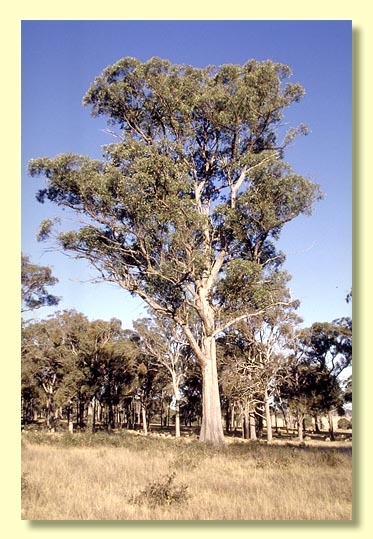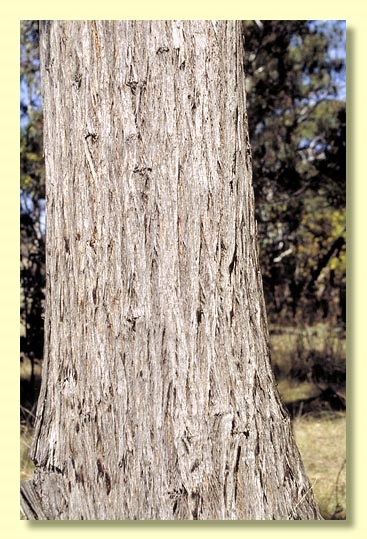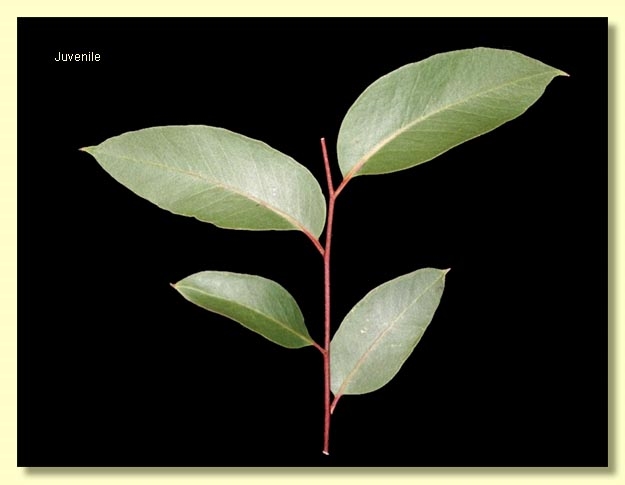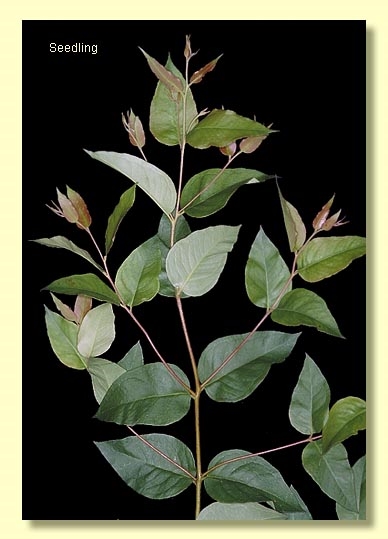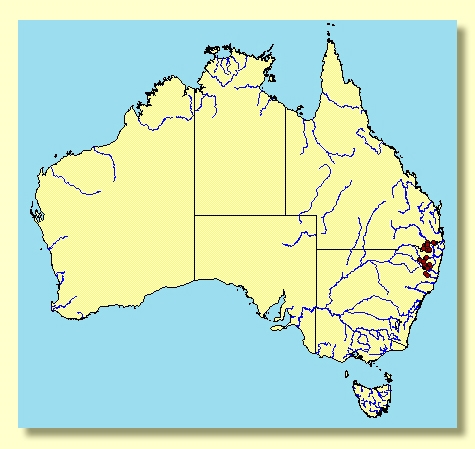Euclid - Online edition
Eucalyptus caliginosa
Eucalyptus | Eucalyptus | Capillulus | Pachyphloius
T: Rosehill, 10.5 km SW of Guyra, NSW, Oct. 1929, E.N.McKie, T.Youman & W.F.Blakely s.n.; a number of specimens in NSW, none with all three collectors on one label.
E. cyathiformis Blakely & McKie, op. cit. 179. T: Booralong, NSW, 28 Oct. 1929, W.F.Blakely, E.N.McKie & T.Youman s.n.; holo: NSW.
Bark rough to small branches, stringy, grey to grey-brown.
Juvenile growth (coppice or field seedlings to 50 cm): stem rounded in cross-section, growing tips conspicuously scabrid; juvenile leaves sessile until nodes 6–8, opposite until nodes 7 to 11 then alternate, petiolate, ovate to broadly lanceolate, 3.5–10 cm long, 1.3–4.5 cm wide, discolorous, green, only ever scabrid on petiole, midrib and margin.
Adult leaves alternate, petiole 0.8–2 cm long; blade lanceolate to falcate, 5–18 cm long, 1.3–3.5 cm wide, base usually quite oblique sometimes tapering to petiole, concolorous or slightly discolorous, glossy, green, side-veins usually acute, sparsely to moderately reticulate, intramarginal vein parallel to and well removed from margin, oil glands island.
Inflorescence axillary unbranched, peduncles 0.5–1.5 cm long, buds in umbels of 7, 9 or ?11, pedicels 0.1–0.4 cm long. Mature buds buds fusiform to obovoid, 0.5–0.6 cm long, 0.2–0.4 cm wide, smooth, scar absent, operculum conical, stamens irregularly flexed, anthers reniform to cordate, versatile, dorsifixed, dehiscing by confluent slits, style long, stigma tapered, locules 3 or 4, the placentae each with 2 vertical ovule rows. Flowers white.
Fruit pedicellate (pedicels (0)0.1–0.4 cm long), cup-shaped, hemispherical, or truncate-globose, 0.4–0.6 cm long, 0.6–0.8 cm wide, disc raised-convex or annular, or level, or slightly descending, valves 3 or 4, usually exserted or near rim level.
Seeds brown, 1–2 mm long, pyramidal or obliquely pyramidal, dorsal surface smooth, hilum terminal.
Cultivated seedlings (measured at ca node 10): cotyledons reniform; stems rounded in cross-section, stellate-hairy; leaves sessile until ca node 7, then becoming petiolate, opposite until node 6 to 10 then alternate, ovate, 4–8 cm long, 2–4.5 cm wide, base rounded to tapering, margin irregular due to hairs, apex pointed, discolorous, darker green and glossy above, paler beneath. Stems and leaves scabrid with stellate hairs to at least node 16, but leaves only ever hairy on margins, petiole and midrib underneath.
Flowering has been recorded in March, May, June, July, September and October.
A small to medium-sized stringybark tree on hills in the Northern Tablelands and North Western Slopes of New South Wales and adjacent areas of Queensland where it occurs on soils of moderate fertility. Eucalyptus caliginosa has coarsely furrowed fibrous bark that extends to the branchlets, fusiform pointed buds, pedicellate fruit 0.6–0.8 cm wide and with more or less exserted valves, and juvenile leaves broadly ovate to lanceolate but only ever sparsely scabrid.
There are several other stringybark species occurring within or near the natural range of E. caliginosa. E. laevopinea has shallowly furrowed rough fibrous bark on trunk and larger branches with smooth-barked outer branches, more ovoid buds on longer pedicels and fruit 0.8–1.4 cm wide but similar juvenile leaves. E. cameronii has smaller almost sessile fruit 0.4–0.6 cm wide and more crowded together, and occurs on richer soil in wetter forests. E. youmanii has slightly angled buds and usually larger fruit, 0.7–1.3 cm wide. E. williamsiana has coarser juvenile and adult leaves and and fruit usually completely sessile and 1.1–1.5 cm diameter. E. mckieana has smaller more flat-topped fruit 0.5–0.6 cm diameter and narrower juvenile leaves.
The ash species E. andrewsii (with two subspecies) occurs in this area also and has furrowed fibrous bark but differs in the smaller cupular to campanulate fruit and strongly petiolate bluish green pendulous juvenile leaves that are never scabrid.

